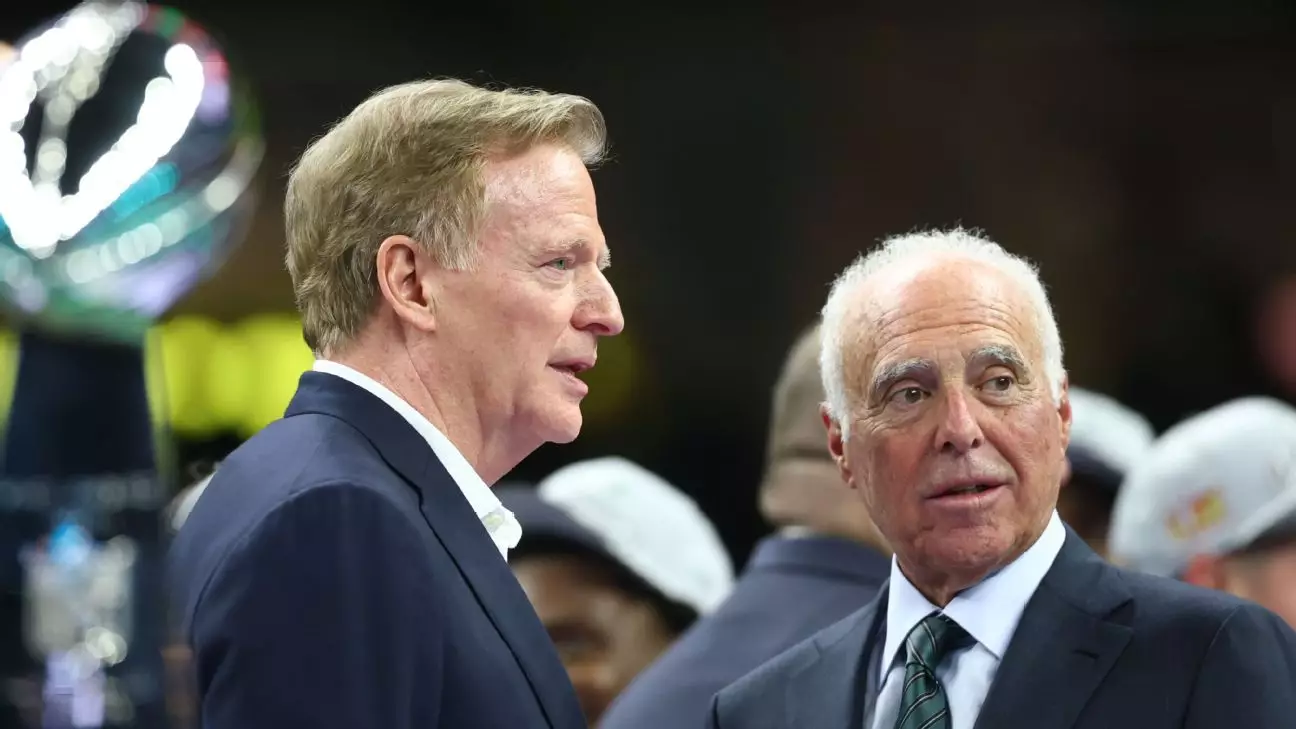The National Football League (NFL) has recently been gripped by a dramatic debate over the controversial play known as the “tush push.” This terminology refers to a short-yardage, quarterback sneak maneuver that has sparked intense discussions about the essence of football itself. During a recent league meeting in Eagan, Minnesota, Philadelphia Eagles owner Jeffrey Lurie took center stage in what can only be described as a desperate plea — a Hail Mary for the survival of a strategy that melds athleticism with raw power. Those of us following American football can see that this is not merely a tactical discussion; it’s a clash of philosophies about the direction of the sport.
Lurie, recognizing the storm brewing over the potential ban of the tush push, delivered a passionate oration that can be labeled as both a defense of innovation and an indictment of conservatism. His arguments were layered with bravado as he likened the play to a juvenile fantasy. The impromptu nature of his comments, while perhaps misguided in context, spoke volumes about the frustrations felt by those who champion creative tactics in a league increasingly defined by regulations aimed at player safety. Yet this begs the question: Are we stifling the very creativity and innovation that make football the engaging spectacle it has become?
Tradition Vs. Modernity
Lurie’s speech inadvertently brought to light a broader philosophical struggle within the NFL. On one hand, you have deep-seated traditionalists who believe in preserving the heritage of the game. On the other hand, there’s a pressing need to adapt to the evolving nature of athletes, technology, and fan expectations. The tension is palpable: should the NFL fortify itself in historical roots or embrace a more dynamic, adaptive approach that might alienate purists?
The remarks from Lurie and other stakeholders reflect a critical juncture. Lurie’s comments—albeit flawed in style—underscore a sense of urgency. The juxtaposition of those who support the tush push against a cohort that wants to ban it reveals an essential truth: Football is as much about spectacle as it is about strategy. The tush push has become a symbol of a narrative that’s been developing across multiple seasons, one where innovation meets skepticism. The responses from owners like Jerry Jones, who engaged with Lurie in a question-and-answer segment, further illustrated the fractious dialogue that exists within the league’s ranks.
The Psychological Warfare of Language
It’s impossible to overlook the impact of language in this debate. Lurie’s comparison of the tush push to a “wet dream” for a teenage boy, while crass, serves as a marker for the generational shift in discourse. The ensuing criticism from NFL executive Troy Vincent reveals not only personal discomfort but also a collective culture grappling with appropriate communication in a high-stakes environment. The emotional reactions illustrate how deeply personal and potentially divisive these discussions can be—even as they revolve around something as seemingly mundane as a football play.
Is there an essential barrier to reform in the NFL, a league historically resistant to change? Critics decry the league’s overreach in safety measures, wondering if such regulations inhibit the very essence of the game. Certainly, the rejection of Lurie’s plea to keep the play alive reflects an entrenched reluctance to accept that the game must evolve if it is to maintain its vigor.
Implications for the Future of NFL Strategy
The failed quest for a ban on the tush push—22 members voted against it, falling short of the necessary 24—should signal to all parties involved that genuine conversations about the future of the NFL are warranted. This incident is more than just a single play; it’s an emblem of broader trends in professional sports culture. The question arises: What constitutes the spirit of football? Is it the shield of safety, or does it require the audacity of risk that could lead to injury?
As the debates rage on, one thing is clear: the tussle over the tush push accentuates a need for re-evaluation within the NFL. As the league forges ahead into a new era, it must balance the juxtaposition of thrilling innovation with its time-honored traditions. Will the NFL evolve to retain its grip on fan engagement, or will it become a relic of its past—a beautifully crafted museum piece, but lacking in vibrancy?

